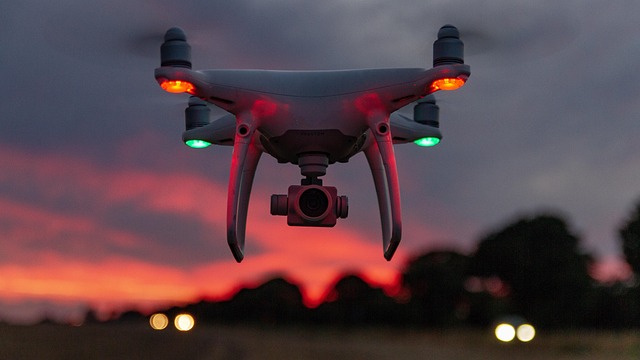Unmanned Aerial Vehicles (UAVs), or drones, are revolutionizing emergency response and threat assessment through unmanned aerial vehicle security. Their advanced sensors provide swift data collection and real-time insights in hazardous areas, enabling efficient monitoring, reconnaissance, and damage assessment. Drones can detect threats like suspicious activity, structural damage, or chemical spills, and their small size allows access to tight spaces. By integrating drone data into security measures, authorities can make informed decisions quickly, enhancing overall security. However, robust cybersecurity protocols are necessary to protect drones from cyber threats and ensure safe operations in diverse environments. Effective collaboration between emergency services, regulatory bodies, and operators is key to successful deployment.
Unmanned Aerial Vehicles (UAVs), or drones, are transforming emergency response and threat assessment. Their rapid deployment capabilities enhance efficiency and timeliness, providing crucial support in critical situations. As advanced sensors, drones offer unprecedented perspectives for threat assessment, enabling more informed decision-making. Integrating drone data into security protocols improves overall safety measures. However, navigating challenges associated with UAVs is essential to ensure public safety in their increasing role within security landscapes.
Unmanned Aerial Vehicles: A Game-Changer in Emergency Response
Unmanned Aerial Vehicles (UAVs), or drones, are rapidly emerging as a game-changer in emergency response and threat assessment scenarios. Their unique capabilities offer unprecedented advantages in terms of unmanned aerial vehicle security, especially in hazardous or inaccessible areas. With their high-resolution cameras, thermal sensors, and advanced analytics, drones can swiftly gather crucial data and provide real-time insights during crises.
These aircraft enable efficient monitoring and reconnaissance, allowing emergency responders to make informed decisions more quickly. The rapid deployment of drones can assess damage, identify trapped individuals, locate resources, and even deliver critical aid, enhancing overall response effectiveness. In today’s digital era, integrating UAV technology into emergency management strategies is a pivotal step towards enhancing security and saving lives.
Rapid Deployment: Enhancing Efficiency and Timeliness
The rapid deployment of drones, or unmanned aerial vehicles (UAVs), is transforming emergency response and threat assessment by significantly enhancing efficiency and timeliness. With their ability to reach remote or hazardous areas swiftly, drones can gather critical data and conduct assessments in a fraction of the time it would take ground teams. This speed is particularly valuable during natural disasters or terrorist attacks, where every second counts.
Moreover, UAV security plays a pivotal role in ensuring safe and effective operations. Advanced encryption and authentication protocols safeguard drone communications, preventing unauthorized access and potential hijacking. Integrating these measures ensures that emergency responders can rely on drone data and actions, fostering a more responsive and coordinated response to critical situations.
Threat Assessment from Above: Drones as Advanced Sensors
Unmanned Aerial Vehicles (UAVs), or drones, are transforming emergency response and threat assessment strategies. With their advanced sensors and high-resolution cameras, drones offer a unique perspective for identifying potential hazards and gathering crucial data in real-time. By providing an aerial view, these aircraft can detect threats that may be missed from the ground, such as suspicious activity, structural damage after natural disasters, or even chemical spills.
The use of drones enhances security measures by allowing swift and precise threat assessment. Their small size and maneuverability enable them to access tight spaces and hard-to-reach areas, ensuring a comprehensive survey. Additionally, drones equipped with thermal imaging and multispectral sensors can detect heat signatures, changes in vegetation patterns, or other subtle anomalies that may indicate potential risks. This capability is invaluable for early warning systems, enabling authorities to make informed decisions and respond efficiently during critical situations.
Integrating Drone Data into Security Protocols
The rapid deployment of drones for emergency response and threat assessment brings about a new dimension in security protocols, as these unmanned aerial vehicles (UAVs) offer unprecedented capabilities for data collection and analysis. Integrating drone data into existing security measures can significantly enhance situational awareness during crises, enabling swift decision-making and targeted interventions. Drone technology provides real-time imagery and sensor data that can fill critical information gaps, especially in hard-to-reach or hazardous areas. This timely intelligence allows security personnel to assess risks, identify potential threats, and allocate resources more effectively.
To maximize the benefits of drone integration, security protocols must be adapted to incorporate UAV data streams. This involves establishing clear operating procedures for drone surveillance, ensuring data privacy and security, and developing robust analysis frameworks that can process the vast amounts of information collected. Effective collaboration between drone operators, security analysts, and law enforcement agencies is essential to ensure seamless integration and optimal utilization of drone data in enhancing overall security measures.
Navigating Challenges and Ensuring Public Safety with UAVs
Navigating the integration of Unmanned Aerial Vehicles (UAVs) into emergency response and threat assessment systems presents a unique set of challenges. Public safety is paramount, requiring robust measures to ensure UAV reliability, security, and safe operations in diverse environments. One significant challenge is securing these drones from potential cyber threats. As UAV technology advances, so do the risks of unauthorized access or malicious attacks, demanding sophisticated cybersecurity protocols to protect against data breaches and system hijacking.
Moreover, effective coordination between emergency services, regulatory bodies, and drone operators is crucial for successful deployment. Establishing clear communication channels, standard operating procedures, and real-time data sharing platforms can enhance overall response efficiency. By addressing these challenges head-on, the responsible introduction of UAVs into critical infrastructure protection and public safety measures can be realized, harnessing their potential to improve emergency response times and save lives.
Unmanned Aerial Vehicles (UAVs), or drones, are emerging as a game-changer in emergency response and threat assessment. Their rapid deployment enhances efficiency and timeliness, providing crucial data for security protocols. By acting as advanced sensors, drones offer unique perspectives that aid in identifying risks and facilitating quicker, more informed responses. However, navigating challenges related to public safety, regulatory frameworks, and data privacy is essential for the successful integration of UAVs into security operations. Embracing these innovations can lead to a safer and more resilient future for communities worldwide.
